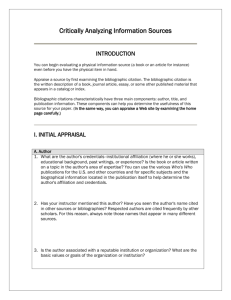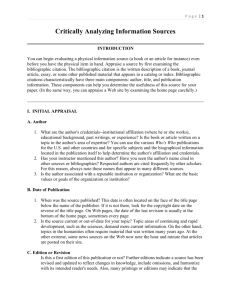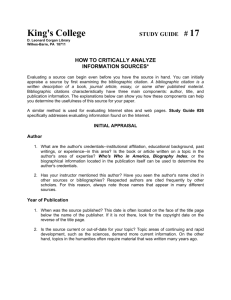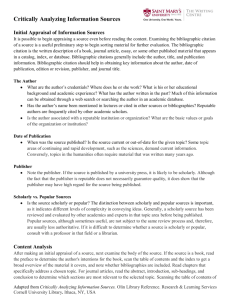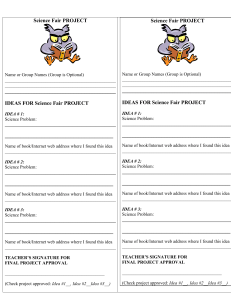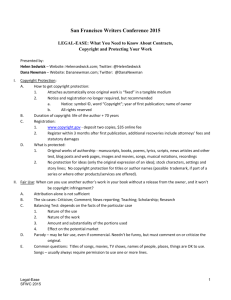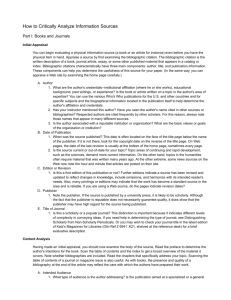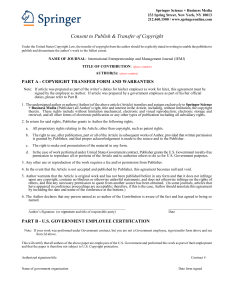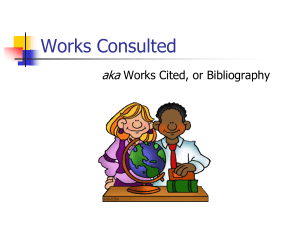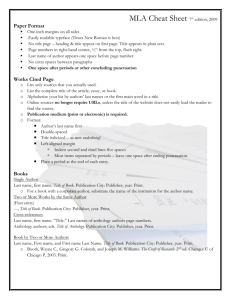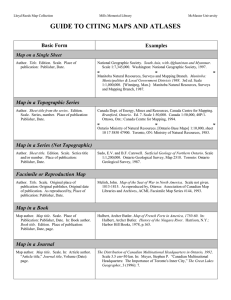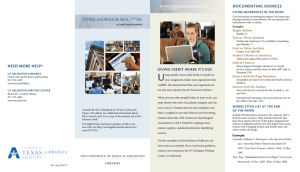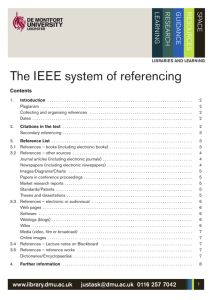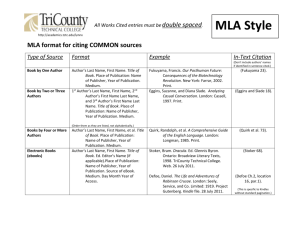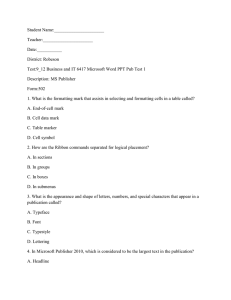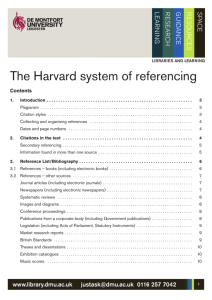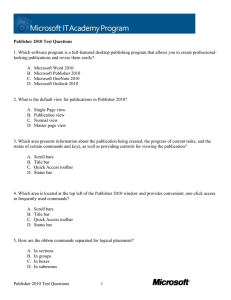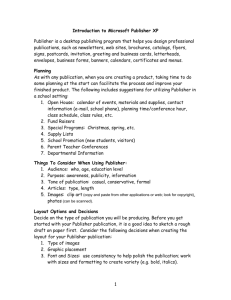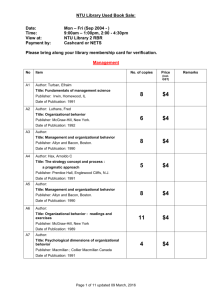Critically Analyzing Information Sources
advertisement
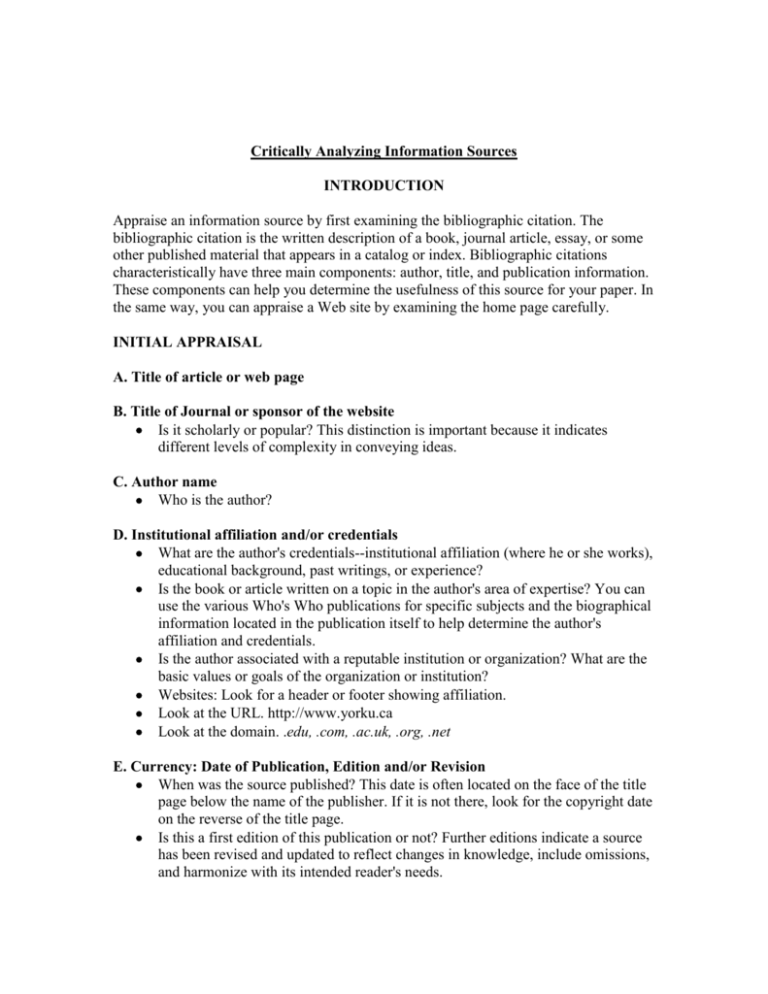
Critically Analyzing Information Sources INTRODUCTION Appraise an information source by first examining the bibliographic citation. The bibliographic citation is the written description of a book, journal article, essay, or some other published material that appears in a catalog or index. Bibliographic citations characteristically have three main components: author, title, and publication information. These components can help you determine the usefulness of this source for your paper. In the same way, you can appraise a Web site by examining the home page carefully. INITIAL APPRAISAL A. Title of article or web page B. Title of Journal or sponsor of the website Is it scholarly or popular? This distinction is important because it indicates different levels of complexity in conveying ideas. C. Author name Who is the author? D. Institutional affiliation and/or credentials What are the author's credentials--institutional affiliation (where he or she works), educational background, past writings, or experience? Is the book or article written on a topic in the author's area of expertise? You can use the various Who's Who publications for specific subjects and the biographical information located in the publication itself to help determine the author's affiliation and credentials. Is the author associated with a reputable institution or organization? What are the basic values or goals of the organization or institution? Websites: Look for a header or footer showing affiliation. Look at the URL. http://www.yorku.ca Look at the domain. .edu, .com, .ac.uk, .org, .net E. Currency: Date of Publication, Edition and/or Revision When was the source published? This date is often located on the face of the title page below the name of the publisher. If it is not there, look for the copyright date on the reverse of the title page. Is this a first edition of this publication or not? Further editions indicate a source has been revised and updated to reflect changes in knowledge, include omissions, and harmonize with its intended reader's needs. Many printings or editions may indicate that the work has become a standard source in the area and is reliable. Is the source current or out-of-date for your topic? On Web pages, do the pages indicate revision dates? The date of the last revision is usually at the bottom of the home page, sometimes every page. Are the links current and updated? F. Publisher Note the publisher. If the source is published by a university press, it is more likely to be scholarly (but not always). Although the fact that the publisher is reputable does not necessarily guarantee quality, it does show that the publisher may have high regard for the source being published. II. CONTENT ANALYSIS G. Physical layout and sections How is the material organized? Do the sections have headings? H. Objective reasoning Is the information covered fact, opinion, or propaganda? It is not always easy to separate fact from opinion. Facts can usually be verified; opinions, though they may be based on factual information, evolve from the interpretation of facts. Are the ideas and arguments advanced more or less in line with other works you have read on the same topic? The more radically an author departs from the views of others in the same field, the more carefully and critically you should scrutinize his or her ideas. I. Coverage – publication type Does the information appear to be valid and well-researched, or is it questionable and unsupported by evidence? Assumptions should be reasonable. Note errors or omissions. J. Reference List: materials referenced The presence and quality of a bibliography at the end of the article may reflect the care with which the authors have prepared their work. K. Writing Style: tone and jargon Is the author's point of view objective and impartial? Is the language free of emotion-arousing words and bias? Skilled writers can make you think their interpretations are facts. L. Intended audience and emphasis What type of audience is the author addressing? Is the publication aimed at a specialized or a general audience? Is this source elementary, technical, advanced or appropriate for your needs? What is the message and the emphasis of the paper? Primary sources are the raw material of the research process. For example, journal articles, theses and conference proceedings written by experimenters reporting the results of their research are primary documents. Secondary sources are based on primary sources. Secondary documents include review articles, abstracts, some books and news articles. Tertiary literature is found in handbooks, field guides and encyclopedias. Permission has been granted to reproduce and adapt this handout for the use of York University Libraries by: Reference Department Collections, Reference, Instruction & Outreach (CRIO) Cornell University Library Ithaca, NY, USA http://www.library.cornell.edu/olinuris/ref/research/skill26.htm
